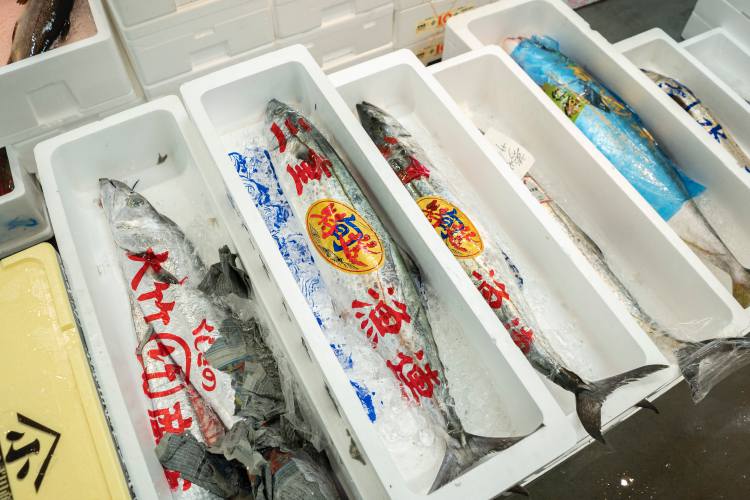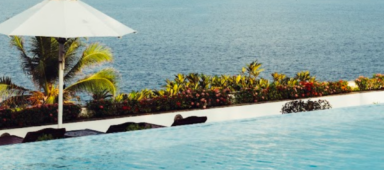When the legendary Tsukiji Fish Market in Tokyo closed its doors in October 2018, it felt like the end of an era. Fondly called ‘Japan’s Kitchen’, the iconic market had been operating for over 83 years and was especially popular among visitors for its tuna auctions.

While tourists can still visit Tsukiji’s outer market and its array of sushi restaurants and shops, wholesale operations have moved to Toyosu Fish Market, a modern, purpose-built facility located two kilometres away. Built and managed by the Tokyo Metropolitan Government, Toyosu sits on a manmade island by the Bay of Tokyo, and at 40 hectares is 1.7 times larger than the old market.

It is here that we find ourselves in the wee hours of the morning, the pungent smell of seafood hitting our nostrils. Despite the early hour, the building is already a flurry of activity, with forklifts piling Styrofoam boxes into neat stacks and electric turret trucks whizzing their way down the aisles.
We are, in fact, a little late to the party. A typical day at Toyosu begins the night before, with trucks arriving from all over Japan bearing fresh catch. By midnight, the seafood will have been offloaded and sent to different parts of the market; to packing facilities for domestic distribution and export, or to the auction area to be sold off to the highest bidder.

The tuna auction begins at 4.30 a.m., lasting for about an hour. At Tsukiji, limited slots were open for the public to experience it up close. This is no longer allowed at Toyosu, though visitors can still view it from a second-floor observation deck or at a lower deck, with advance bookings.
Even from afar, the auction is fascinating to observe. Wild tuna can clock in at up to 300 kilogrammes, and the sight of these gargantuan specimens all laid out in a row is not something that one gets to see every day.
At 4 a.m., buyers start evaluating the fish, checking the colour and fattiness on each. When the floor opens, signalled by the ringing of a bell, buyers raise their hands using the teyari, or digit gestures, to indicate their respective bids and the quantity of products they want to purchase.
The auctioneer discerns the highest bidder among the many fingers raised and informs the crowd who has won the product. The items will then be sent to the respective intermediate wholesalers, to be sold to businesses such as restaurants, supermarkets and retail outlets.

We follow the progress of the purchased catch to the Intermediate Wholesale Fish Building, where temperatures hover at a cool 20 to 25 degrees. At one of the shops, the giant fishes are laid out on cutting tables, where they are skilfully carved up with metre-long knives. Each cut is beautifully executed to minimise wastage. We learn that it may take apprentices two years before they are able to slice up a tuna on their own.

Venturing to Yamaharu Co., Ltd – the largest intermediate wholesaler in Toyosu – we find company president Yasuhiro Yamazaki. An affable figure in rubber boots and a hachimaki (traditional headband), Yamazaki is one of the many intermediate wholesalers who have shifted their decades-old operations from Tsukiji Market.
The variety at his shop is astounding: plump, juicy oysters the size of human heads, gigantic crabs, live lobsters, sea pineapples and glistening boxes of uni (sea urchin). Most are for domestic consumption, but 30 percent will be exported to places such as Hong Kong, United States and Taiwan.
“The new market is good. There’s temperature control to keep the seafood fresh, and it’s much more hygienic,” says Yamazaki, who has been in the business for over 38 years. “Some people had mixed feelings moving here, since Tsukiji had such a long history. But the people inside the market, as well as their skills, have not changed,” he adds.
Indeed, if you’ve ever been to Tsukiji, the atmosphere and techniques at Toyosu are comfortingly familiar, down to the practice of ikejime – the traditional method of slaughtering fish to maintain the quality of its meat.
Another old business that has made the shift to Toyosu is Dai Ichi Suisan Co., Ltd, first established in 1948. One of three first wholesalers at Toyosu, they are licensed by the Japanese government to purchase seafood goods from fishermen and suppliers from all over Japan, which are then sold to the intermediate wholesalers within Toyosu. The company deals with 100 metric tonnes of seafood per day.

“Tsukiji was special for the Japanese people. I remember how seafood used to come into the market on freight trains,” recalls Hiroyuki Taguchi, president of Dai Ichi Suisan Co., Ltd, who started helping out with his father’s business 50 years ago when he was 22.
“Later on, trucks became the main mode of transportation, and the facilities were not designed for it. The open layout also made it easy for pests such as rodents to come in,” he says. “The new facilities at Toyosu are much more sanitary, and we are able to control the quality much better in order to provide the best seafood for consumption both local and abroad,” he adds.
Old Ways, New Future

According to Yamazaki, one of the current difficulties faced by the fishing industry is rising sea temperatures, which have affected the availability of certain types of seafood. For example, the catch for the Pacific saury has been extremely bad; little over 1/30th of the previous year’s haul.
“The season for fish is changing. It has been difficult to forecast what the seasonal fish will be,” he says. However, Yamazaki is confident that there will still be a constant fish supply – it is simply a matter of adapting to these changes.

“There is a stereotype in Japan as to which month is best to eat a particular fish. Before, it may be best eaten in December, but now it may be good to eat in February instead,” he explains. Yamazaki is keen to study these changes in order to continue supplying good products to customers.
His sentiment is echoed by Taguchi.
“The overall catch has gone down, so it is a luxury for the Japanese to be able to enjoy such good seafood. The domestic fish market may not grow in the future, so we have to look abroad and focus on exports. Since Japanese cuisine is getting popular all over the world, I’d like for people, including Malaysians, to be able to enjoy this as well,” says Taguchi, adding that it is important to export not only expensive seafood but also the ordinary kind that the Japanese eat on a daily basis.
Worth A Visit
Toyosu is primarily built for business, so general visitors are not allowed into the wholesale area. While it feels almost sterile and lacks the traditional charm and up-close action one could get at Tsukiji, that isn’t to say that it’s not worth visiting – especially if you’re keen for a glimpse into what goes on behind Japan’s multi-billion-dollar seafood industry.

Some of the tourist facilities include a display room near the second-floor observation deck for the tuna auction, which features photos explaining the auction’s history and several interesting exhibits, such as the market’s iconic turret truck. While you’re here, snap a souvenir photograph with the life-sized replica of the biggest bluefin tuna ever sold at the Tsukiji auction – a monster half-tonne specimen.

The third floor of the Fisheries Intermediate Wholesale Market (Block 6) houses more than 40 food stalls, including popular restaurants such as Sushi Dai and Nakaya Tsukiji, both former tenants at the old market. The queue at the former starts as early as 6 am, with diners looking for a taste of fresh sushi and sashimi, made from seafood delivered straight from the market downstairs.
Meanwhile, the fourth floor of the building is occupied by Uogashi Yokocho, which caters to restaurant chefs and other professionals but also offers a wide selection of food, snacks, kitchen utensils and other items for general visitors. This is where you can get spices, dishware, packaging, high-grade chef knives and souvenirs. For a dash of greenery, head up to the landscaped rooftop garden, which offers epic views of the Tokyo skyline from across the bay.
Plans are also in the works for a section where the general public can purchase fresh goods, including fish and vegetables, as well as an onsen, scheduled to open in 2023.
*The writer travelled to Toyosu Fish Market as a guest of Sendo Ichi Seafood (M) Sdn Bhd and Ocean Trading Co., Ltd.




